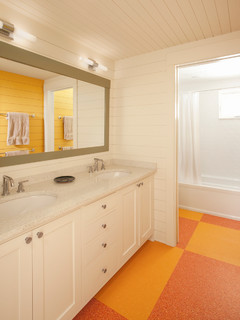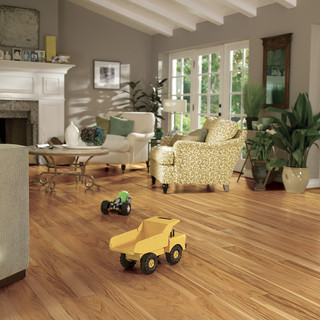
Picking from so many hard-surface floor coverings is a real challenge. There are different materials to consider, and then you have to pick a color and pattern. Flooring is a big investment so you want to take your time and get it right, for your family and your home. It's not only the initial cost but how easy the floor will be to maintain and that has a lot to do with whether the flooring you want is appropriate for the room where you’ll install it.
It's difficult to list all the hard-surface floor coverings you have to pick from. But with this simple guide, you’ll learn the basics of the most common flooring options.
Solid Wood Floor Coverings
Although the term is sometimes used to describe any wood floor, “hardwood” only applies to actual hardwoods, such as black walnut, red and white oak, and aspen. Pine isn’t a hardwood, but it still makes a beautiful floor. Whether the wood is hard or softwood, the fabrication is generally the same.
Solid wood flooring is just what it says: solid, through and through. Each board is cut from a single piece of wood to a thickness of between 3/4 and 5/16-inch. Some of the most popular solid wood floorings are tongue-and-groove. This means a groove is notched along one edge and a tongue, or a projection, is cut along the opposite edge. This lets the boards interlock along the edges.
Solid wood flooring is appropriate on almost any above-grade room, but it’s not recommended for basements. Anywhere the floor could be threatened with water might be better served using another flooring.
Engineered Wood Floor Coverings
 Don’t let the name fool you. Engineered wood is not a subpar product; in some applications, it’s better than solid wood. Once installed, you won’t see a difference between solid and engineered wood flooring.
Don’t let the name fool you. Engineered wood is not a subpar product; in some applications, it’s better than solid wood. Once installed, you won’t see a difference between solid and engineered wood flooring.
Engineered wood is fabricated in layers. The uppermost layer is the beauty layer, with the best wood grain. The underlying layers have wood grain running in different directions. The layers give engineered wood a great deal of strength, and resistance to swelling and shrinking from humidity. Engineered wood also withstands wear and tear better because it was finished in the factory
This material is appropriate almost anywhere in the house. It’s even safe below-grade where dampness could be a problem for solid wood.
Linoleum Floor Coverings
 Another word that’s often misused, linoleum refers to a specific flooring material. If the floor has a faux marble finish or floral designs, it’s not linoleum — it’s actually vinyl.
Another word that’s often misused, linoleum refers to a specific flooring material. If the floor has a faux marble finish or floral designs, it’s not linoleum — it’s actually vinyl.
Linoleum is one of the greenest flooring options on the market. It’s made from linseed oil and other natural materials. It comes in surprising range of colors from muted beige to vibrant, crayon-box shades, and is available in sheets or 12-inch tiles.
Linoleum is appropriate all over the house. It’s resilient, too. If you accidentally damage it, chances are you can repair the damage instead of living with a ruined floor. The color and material is solid throughout. If there’s a scratch, hole, stain, or burn, you can usually sand or buff it out and the floor will look the same as it did before.
Vinyl Floor Coverings
 Vinyl flooring has come a long way. No longer limited to solid colors and predictable patterns, modern vinyl can be fabricated in sheets, tiles, and planks that look like almost anything, from wood to stone tile. Some vinyl tiles are even groutable using special grout.
Vinyl flooring has come a long way. No longer limited to solid colors and predictable patterns, modern vinyl can be fabricated in sheets, tiles, and planks that look like almost anything, from wood to stone tile. Some vinyl tiles are even groutable using special grout.
Vinyl is one of the most easy-care flooring choices available. Simply sweep and damp mop regularly. No wax necessary. However, vinyl is easy to damage. Scratches can cut through the sealed surface, and burns will melt the material. Repairs often require cutting out the damage and inserting a patch.
Laminate Floor Coverings
 Laminate looks like wood flooring, but contains little or no wood at all. In most cases, laminate has a hard plastic backing, an image layer over that, which is nothing more than a photograph of real wood grain, and a sealer on top, that's usually plastic. This might sound cheap, and some laminate is, but this flooring can also look great and is as easy-care as vinyl.
Laminate looks like wood flooring, but contains little or no wood at all. In most cases, laminate has a hard plastic backing, an image layer over that, which is nothing more than a photograph of real wood grain, and a sealer on top, that's usually plastic. This might sound cheap, and some laminate is, but this flooring can also look great and is as easy-care as vinyl.
Laminate is usually installed as a floating floor. This means none of the flooring sections are nailed or glued to the subfloor. They interlock at their tongue-and-groove edges, sometimes with glue at the seams. Laminate is appropriate in almost any room, including basements, but requires special installation techniques on a staircase.
Tile Remains a Popular Flooring Material
Tile has been around for so many years, it’s hard to even say. It may be ceramic, porcelain, glass, or stones such as slate, granite or marble. One important thing to remember is there is a difference between wall and floor tiles. Porcelain and ceramic wall tiles are not strong or durable enough to be used as flooring, but the same material made for floors is much stronger.
DIY shows on TV have given homeowners the confidence to install floor tiles. But you must have the right support underneath tile or it will crack or come loose, problems that we dealt with every month when I was running my handyman business. The subfloor must be re-secured with screws so it doesn't move up and down. Then cement board, the “underlayment” must be installed to provides additional support so just in case you're planning to install your own tile, do your homework and here's a good video to take you through the steps to preparing a floor for tile.
Picking out new hard-surface flooring shouldn’t be taken lightly. Consider your home and family’s needs first. If you have active kids and pets, vinyl could suffer a lot of damage. You’ll want something more durable, such as wood or tile. In a low-traffic home, softer, solid-surface flooring might hold up beautifully.
There’s a lot more to selecting a new floor than deciding on a color and price. With the right choices, your new flooring should last for many years.




Leave a Reply